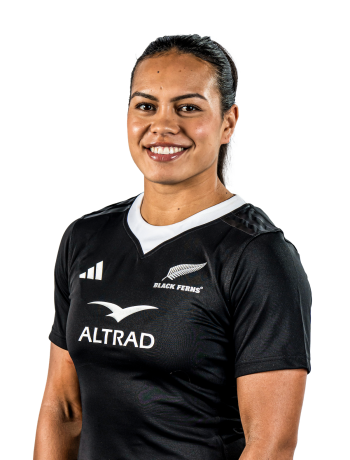PLAYER PROFILE
Layla Sae
Flanker
KEY STATS
Black Ferns Next match

Black Ferns

Australia Women
BIOGRAPHY
Black Fern #256
Layla Sae is a dynamic flanker from Manawatū who has overcome type 1 diabetes, an ailment from which she’s suffered since she was four, to become a leading loose forward in New Zealand.
Contracted to the Black Ferns in April 2023, Sae made her debut in the 43-3 thrashing of Australia in Hamilton in September of the same year and was capped twice more in the inaugural WXV1 series.
“I had a celebration cider. One, just one,” Sae laughed when she was first selected.
Her athleticism and physicality were to the fore when she started in the record 70-7 victory over Wales in Dunedin in WXV1. The fact Sae has scaled such heights is impressive when one considers the challenges her diabetes presents.
“Some people think I’m getting special treatment when the trainer runs on the field with Powerade and lollies. It’s because I’m gassed,” Sae says.
“I stay on top of my blood sugar levels by achieving the right balance in my diet. I inject insulin when I’m low and increase sugar when needed.
“Every person has challenges. I see diabetes as my challenge, but I don’t think about it as a burden. I don’t remember what it was like not to have it. It’s basically my normal, which seems a bit hectic to others.
Rod Kafer (Australia), James Lowe (Ireland), and Henry Slade (England) are rugby internationals who suffer from type 1 diabetes. White Ferns cricketer Sophie Devine has managed the ailment successfully, while perhaps the most famous to suffer the disease is five-times Olympic rowing champion Sir Steve Redgrave.
Raised in Palmerston North, Sae initially played football, but it was in volleyball where she made the biggest impression. Her mum is her biggest supporter, and her dad is into all sports, “so I didn’t have much choice to do anything else.”
She was a New Zealand age group volleyball representative and achieved a significant slice of history at the secondary schools nationals in 2018.
“I was named in the tournament team at nationals, the first player in something like 50 years from the lower North Island to be named in that team. I play left-hand opposite, which is quite unusual. I’m a confident attacking player and was good at seeing opportunities to score before they happened.”
Opportunities to play rugby at St Peter’s College were limited but Sae was attracted by the camaraderie of the code.
“We played Tens. If you had a mouthguard, you were in the team. I had no idea to start with but, as I grew more confident, I grew to love the contact, the outlet of aggression, tackling, leg drive, rucks, the whole physical aspect was awesome.”
Sae withdrew from sports when she left high school in 2018 and worked in a factory packing frozen meat. It was gruelling work with a means-to-an-end the only purpose. She was persuaded to start playing rugby again by Manawatū Cyclones halfback Sarah Swinbanks in 2019.
Strong displays for Old Boys Marist earned her a place in the Cyclones for the Farah Palmer Cup (FPC). It was a baptism of fire, with Manawatū losing all six matches that season.
Only Covid spared Manawatū being relegated for the next season, as the competition was divided into North and South divisions.
But in that following season, in 2020, the Cyclones were exceptional, demolishing Tasman by a record 88-0 and shocking Wellington at Sky Stadium.
Better was to come in 2021. Manawatū won the re-conceived Championship, scoring more points (328) and tries (48) than any team in the FPC. Sae scored two tries in a 67-12 slaughter of Hawke’s Bay but missed the final against the Tūi with an ankle injury.
“Winning the championship is the highlight of my Manawatū career so far. We had such a relaxed environment where we shared openly and were encouraged to express ourselves,” Sae says.
And then it was on to Super Rugby Aupiki.
The lingering menace of Covid severely disrupted that competition in 2022. The inaugural edition was incomplete and inferior when contrasted with the vibrant and tight 2023 offering.
The Hurricanes Poua were third, railing from a hefty halftime deficit to topple eventual champions Matatū 25-24 in Christchurch. A loss in Wellington against the Blues, after leading for most of the match, was a disappointment, but in a playoff the Blues were afforded no mercy, beaten 29-24 and closing a large gap only by scoring a late try. Sae was the seventh-highest tackler with 51 and carried combatively to capture the attention of the Black Ferns selectors.
She was even better in 2024. The Poua was last, but the form of Sae was sensational. In her last match against the Blues, she made 21 tackles and scored a try. A week earlier, with Poua 22-0 down against Matatū, Sae sprinted 45 metres off the back of a scrum for a try and almost did it again with another gut-busting burst. In the round-robin, she beat the most defenders with 41 and ranked second most tackles (84).
Manawatū returned to the FPC Championship in 2023 and beat every side in the competition, but lost the final narrowly to Northland. Sae ranked among the top 30 tacklers and carriers.
Sae is named after the Eric Clapton ballad Layla. Clapton wrote the classic for model and photographer Pattie Boyd, who would later become his wife.
“I wasn’t named for like a week after I was born. Dad heard Layla on the radio and that became my name. I’m told it means angel, which is cool, but to be honest I prefer hip hop!”
Profile by Adam Julian.
